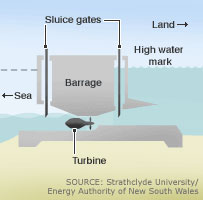Intermittent electricity

Intermittent electricity is electrical energy that is not continuously available due to external factors that cannot be controlled, produced by electricity generating sources that vary in their conditions on a fairly short time scale. Sources of intermittent electricity include solar power,[2] wind power,[3] tidal power, and wave power.[4] Although solar and tidal power are fairly predictable (length of days, weather patterns, tidal cycles), they are still intermittent because the time period that electricity can be created is limited. Because of this varying electrical generation these sources are considered non-dispatchable, meaning that their electrical output cannot be used at any given time to meet societies fluctuating electricity demands.
Intermittency can be constrained or even overcome by the use of electricity storage, which is a very rapidly developing area of research. These intermittent sources can store their electricity for later use, and once this pairing is perfected the possibilities are truly limitless.[5] Tesla motors is already mass-producing such energy storage devices, which can harness intermittent solar energy by connecting to solar panels, allowing home owners to use their solar power at otherwise unusable hours. Owners of these storage devices can avoid paying peak-time prices for electricity, and have a reliable source of electricity at all times even in the event of a power outage.[6]
The most common and highest contributing intermittent sources are wind and solar. They are looked at in a little more detail below.
Solar power
Solar power is intermittent and most often non-dispatchable. Solar energy to the Earth is not the same in all locations, and is also affected by cloud cover. The main reason that solar power is intermittent however is the fact that the Sun does not shine for all hours of the day in a given location.[7] Therefore it is impossible to make consistent use of this resource for electricity generation without the use of electricity storage.
Since the length of days and weather effects are fairly predictable, there are power plants that use heat storage from the solar energy in order to produce power when the sun isn't shining.
Wind power

Wind power is considered highly intermittent and non-dispatchable because it is a variable power source, meaning that its electrical output depends on many factors, such as wind speed, air density, turbine characteristics, and more. All of these factors also change depending on location of the site. Wind speed must also be in a certain range (depending on the turbine), above 3.5 m/s in order to generate electricity, and below 25 m/s to avoid damage to the turbine.[9] When taking multiple wind farm's intermittency into consideration, it would make sense that the reliability would somewhat increase, but this actually doesn't appear to be the case.[10]
Wind power is by far the primary energy source that most need high quality energy storage options. One option compressed air energy storage seems particularly promising.
Tidal power

Tidal power harnesses the energy from the tidal force and wave action in order to generate electricity. Unlike other primary energy flows, it is a predictable source of energy because tides occur at expected times.[12] This predictability has an advantage over wind and solar power since the sun may or may not shine on a particular day and the wind doesn't always blow the expected amount. Tidal power is still not a dispatchable source of electricity as it is available when nature provides it, not necessarily when it is needed.[13]
References
- ↑ Wikimedia Commons [Online], Available: http://upload.wikimedia.org/wikipedia/commons/4/45/Giant_photovoltaic_array.jpg
- ↑ Renewable Energy World, Solar Intermittency: How Big is the Problem? [Online], Available: http://www.renewableenergyworld.com/articles/2011/11/solar-intermittency-how-big-is-the-problem.html
- ↑ DASH, Meteorologically Defined Limits to Reduction in the Variability of Outputs from a Coupled Wind Farm System in the Central US [Online], Available: http://dash.harvard.edu/bitstream/handle/1/10981611/Meteorologically%20defined%20limits%20to%20reduction%20in%20the%20variability%20of%20outputs%20from%20a%20coupled%20wind%20farm%20system%20in%20the%20Central%20US_1.pdf?sequence=6
- ↑ EDF Energy, Wave power is intermittent but tide power is predictable [Online], Available: http://www.edfenergy.com/energyfuture/energy-gap-reliability/marine-and-the-energy-gap-reliability
- ↑ Renewable Energy World, Solar Power and Energy Storage: Pairing Technologies Vital to Our Future [Online], Available: http://www.renewableenergyworld.com/articles/2013/09/solar-power-and-energy-storage-pairing-technologies-vital-to-our-future.html
- ↑ Tesla, Powerwall [Online], Available: http://www.teslamotors.com/powerwall
- ↑ Renewable Energy World, Solar Intermittency: How Big is the Problem? [Online], Available: http://www.renewableenergyworld.com/articles/2011/11/solar-intermittency-how-big-is-the-problem.html
- ↑ Wikimedia Commons [Online], Available: http://upload.wikimedia.org/wikipedia/commons/0/0d/Darling_Wind_Farm.jpg
- ↑ DASH, Meteorologically Defined Limits to Reduction in the Variability of Outputs from a Coupled Wind Farm System in the Central US [Online], Available: http://dash.harvard.edu/bitstream/handle/1/10981611/Meteorologically%20defined%20limits%20to%20reduction%20in%20the%20variability%20of%20outputs%20from%20a%20coupled%20wind%20farm%20system%20in%20the%20Central%20US_1.pdf?sequence=6
- ↑ David JC McKay, Sustainable energy - without the hot air [Online], Available: http://www.inference.phy.cam.ac.uk/withouthotair/c26/page_187.shtml
- ↑ Strathclyde University/Energy Authority of New South Wales
- ↑ EMEC. (Accessed July 30, 2015). Marine Energy [Online], Available: http://www.emec.org.uk/marine-energy
- ↑ Vision of Earth. (Accessed July 30, 2015). How can renewables deliver dispatchable power on demand? Available: http://www.visionofearth.org/industry/renewable-energy/renewable-energy-review/how-can-renewables-deliver-dispatchable-power-on-demand

